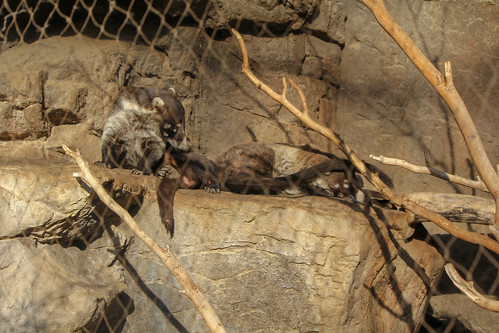He evicted meerkats (table two). (d) Is intergroup roving by male meerkats
He evicted meerkats (table two). (d) Is intergroup roving by male meerkats associated with PubMed ID:https://www.ncbi.nlm.nih.gov/pubmed/23737661 a greater risk of becoming infected with Mycobacterium bovis by either the roving male or members of the group becoming visited, or each Intergroup roving by male meerkats was substantially correlated using the rovers themselves being infected in two out of eight time points, and this correlation remained when all eight time points were analysed with each other (p 0.00, table 3: outdegree; figure 3c). Members of either sex in groups frequently visited by rovers from elsewhere were not, nevertheless, at enhanced risk of getting infected (table three; indegree). This suggests that, for individual meerkats, becoming a rover carries additional risk of TB infection than does becoming visited by rovers from other groups. (e) Is involvement in aggressive intergroup encounters associated with tuberculosis danger No association was located among involvement in aggressive intergroup encounters and any transform in M. bovis infection status of group members (table 4; figure 3d ).Proc. R. Soc. B (200)4. Exposure time was much less important than involvement in certain social interactions in influencing TB risk. Infection in meerkats was a lot more often related with groomers than groomees, suggesting that meerkats which groom other individuals are at higher risk of infection than are those that get grooming. An uninfected meerkat that grooms an infected person is likely to be at danger of infection by at the least three routes: from inhaling infectious aerosols, from bite wounding (injection of infection) and by ingesting infectious bacteria from draining sinus tracts. Although all 3 of those transmission routes seem to occur in meerkats (Drewe et al. 2009b), the greatest risk is likely to result from inhalation owing to the low minimum infective dose of this route: five bacilli or fewer are enough to establish pulmonary infection in cattle (Chausse 93, cited by Phillips et al. 2003) compared using the oral route exactly where several million bacilli are required to establish infection owing towards the mycobactericidal effects of gastric secretions (Gaudier and GernezRieux 962, cited by Corner 2006). Thus, despite the high prevalence of discharging lymph node abscesses in infected meerkats (Drewe et al. 2009b), meerkats that ingest modest amounts of infectious pus during grooming of such folks may well truly be at a low risk of establishing infection owing towards the requirement to get a extremely high oral dose (Corner 2006). Danger is likely to improve with duration of grooming but this was not measured in the present study. Meerkats on the getting finish of TA-02 custom synthesis aggression (these having a higher aggression indegree centrality score within the preceding 3 months) were far more likely to turn out to be infected with M. bovis than those that received much less aggression. Though this getting was not constant more than each of the eight time periods studied, a important overall correlation was noticed when all time periods had been analysed collectively. Intragroup aggression in meerkats may well  result in serious bites, suggesting that direct inoculation of M. bovis via bite wounding may possibly take place. Injection of infected saliva through bite wounds is believed to be an important means of TB transmission in badgers (CliftonHadley et al. 993) and this has been linked to subsequent haematogenous640 J. A. Drewe Tuberculosis transmission in meerkats spread of M. bovis infection (Jenkins et al. 2008). Meerkat saliva may possibly often be infectious (possibly due to the fact of contamination with respira.
result in serious bites, suggesting that direct inoculation of M. bovis via bite wounding may possibly take place. Injection of infected saliva through bite wounds is believed to be an important means of TB transmission in badgers (CliftonHadley et al. 993) and this has been linked to subsequent haematogenous640 J. A. Drewe Tuberculosis transmission in meerkats spread of M. bovis infection (Jenkins et al. 2008). Meerkat saliva may possibly often be infectious (possibly due to the fact of contamination with respira.